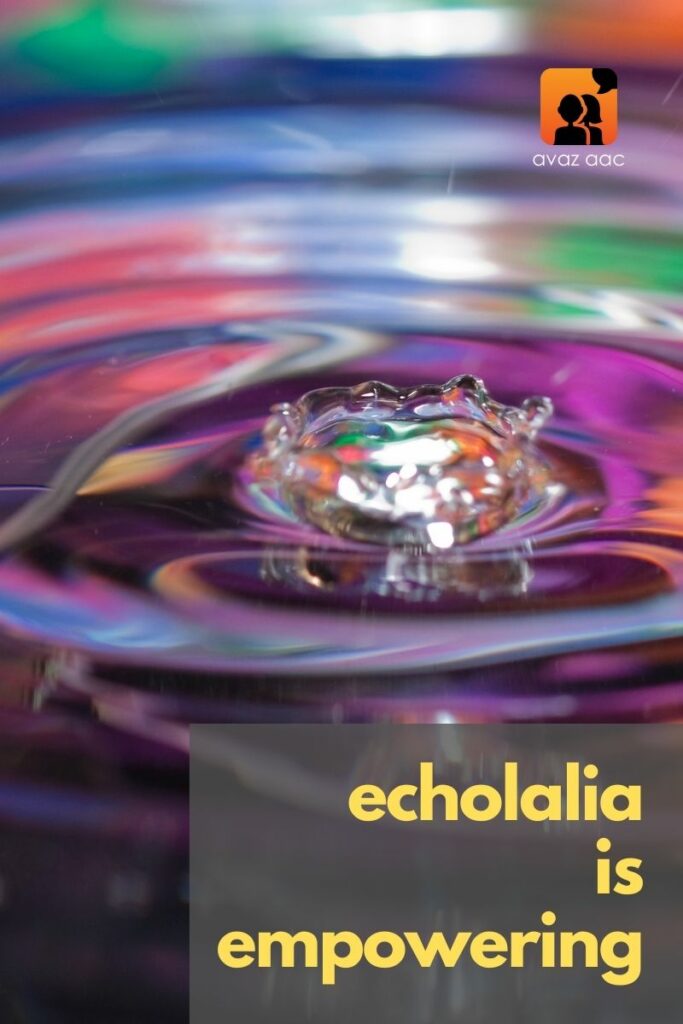Echolalia is an important stepping stone to communication for many autistic individuals. This blog tells you why and how it facilitates this.
Echolalia is the repetition of words and phrases. Instead of responding to a question, a child may ask it again. For example: when the parent or caregiver asks “Do you want water?”. The child replies with “You want water”.
Echolalia is classified into Delayed and Immediate. Research has indicated that echolalia can have a communicative purpose.
Communication and Echolalia
Echolalia is more prevalent among autistic individuals. As per research, it is beneficial for establishing language and developing speech. Hence, autistics with echolalia may see better language development.
This tells us that we should not be aiming to remove echolalia. Instead, we can utilize it to facilitate communication more effectively!
Latest research indicates that Echolalia is a form of meaningful communication. It is critical that we comprehend its significance in order to improve communication. Identifying the best intervention techniques help in enhancing the language of communicators.
How Does Echolalia Improve Communication?


Identify moments where your child has a desire for something to help build communication with you. For example: when your child wants a crayon. Hold the crayon and ask “What do you want?’. Follow it up immediately with a prompt to help the child by saying “ I want a crayon”. Then hand over the crayon to them. Upon repetition of this habit, the child will understand and communicate when the situation arises.
Helping children learn the language for requesting can help them communicate more effectively over time. Instead of constantly repeating the words or phrases, pause to let them communicate and repeat after you.
Autistic children typically employ echolalia when they don’t know what to say in response to a query or order. At times like this, teaching them to say “I don’t know” will add to their vocabulary. Prepare a set of questions – some of which your child knows how to respond to and some which they don’t. This will help them to learn to respond with “I don’t know”. When they don’t know the answer to something, prompt them with “I don’t know.”
An Interactional Concept
Echolalia is an interactional concept. It becomes evident when it is used for Negotiation and Distraction.
Negotiation:
Children with autism also adopt echolalia to negotiate with their interaction partner. This comes through especially when a favored activity is nearing its finish. For example, a parent or caregiver telling “5 more minutes” to the child during playtime. In turn the child repeats “5 more minutes” at a slower pace. This shows that the child is negotiating with the parent for longer playtime.
Distraction:
Echolalia is also used as a subject switcher and a diversion. This frequently happens when the child’s interaction partner brings up an unfavorable subject. For example, a child may repeat things that have heard elsewhere. They may do this to switch the conversation to a topic that is more interesting to them.
How Echolalia Supports Autistic Individuals
Recent studies have revealed that children with autism use echolalia to communicate when they find spontaneous speech difficult.
Echolalia used to be characterized as a negative, meaningless and stereotypical habit. Today however, many researchers explore echolalia’s communicative function. It has been found to be a child’s adaptive response to language development challenges. It is also seen as a promising indicator of future language development.
People with ASD may repeat their own or others’ words. They may also repeat through audio/video assistance from AAC devices.
Apart from assisting with language development, including vocabulary, echolalia helps through conversational turn-taking. This supports autistic individuals to communicate and connect with others. This builds relationships and social-emotional connections with others around them.
We can follow the child’s lead. When echolalia is present, we can implement low-constraint language models like remarks, affirmations, and introspective questions. This can help children on the spectrum acquire natural language skills. This sets the direction for higher-level communication like seeking information or giving an opinion. In this case, it creates an opportunity for more communication.
Conclusion
There is no doubt, echolalia is a stepping stone to communication.
75% of children with autism use echolalia to communicate with their parent or caregiver. It is important to remember that there’s no right or wrong way to develop language.
Children with autism can develop their verbal skills with its help. Instead of suppressing echolalia in autistic children, we can use it to help them improve their communication and speech development. A variety of communicative tools and instructional methods can be used with a Speech Language Pathologist’s assistance to support your child.
The hope is that the voices of autistic children will be heard. To interact and establish individuality, not only via repetition but also through new and improved language.



